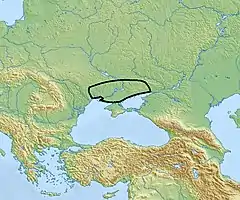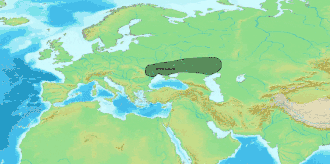Mikhaylovka culture
The Mikhaylovka culture, Lower Mykhaylivka culture (3600—3000 BCE)[1][2] is a Copper Age archaeological culture which flourished on the Pontic steppe from 3600 BC to 3000 BC.

| Part of a series on |
| Indo-European topics |
|---|
 |
Lower Mikhaylovka culture is named after an early Yamna site of the late copper age of the lower Dnieper River, noted for its fortifications.[1][2]
Lower Mykhalivka culture is named after lower archaeological layer of the site near Mykhaylivka village of Kherson Oblast.
Mikhaylovka I (3600-3400 BCE)[2] had connections to the west,[2] and is related to the Kemi Oba culture (3700-2200 BCE) at the Bug-Dniepr area and the Crimea, and seems to have had connections to the Maykop culture (3700-3000 BCE).[1]
Mikhaylovka II (3400-3000 BCE)[2] had connections to the east, as reflected by its Repin-style pottery.[2] Mikhaylovka II is divided into a lower (3400-3300 BCE) and an upper level (3300-3000 BCE).[2] Mikhaylovka II shows a shift from farming to cattle herding, typical for the Yamna horizon.[3]
References
| Wikimedia Commons has media related to Lower Mikhaylovka culture. |
- Mallory 1997.
- Anthony 2007, p. 320.
- Anthony 2007, p. 320-321.
Sources
- Anthony, David W. (2007), The Horse, the Wheel, and Language: How Bronze-Age Riders from the Eurasian Steppes Shaped the Modern World, Princeton University Press, ISBN 978-0-691-14818-2
- Mallory, J. P. (1997), "Lower Mikhaylovka group", Encyclopedia of Indo-European Culture, Fitzroy Dearborn